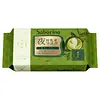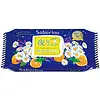What's inside
What's inside
 Key Ingredients
Key Ingredients

 Benefits
Benefits

 Concerns
Concerns

 Ingredients Side-by-side
Ingredients Side-by-side

Water
Skin ConditioningGlycerin
HumectantIsopentyldiol
HumectantHydrogenated Polydecene
EmollientAscorbyl Glucoside
AntioxidantGlyceryl Glucoside
HumectantSphingomyelin
Skin ConditioningMentha Citrata Leaf Extract
AstringentMelaleuca Alternifolia Leaf Extract
PerfumingMelaleuca Alternifolia Leaf Oil
AntioxidantHoney
HumectantSodium Hyaluronate
HumectantMalic Acid
BufferingSoluble Collagen
HumectantMilk Extract
Skin ConditioningButylene Glycol
HumectantPEG-60 Hydrogenated Castor Oil
EmulsifyingAcrylates/C10-30 Alkyl Acrylate Crosspolymer
Emulsion StabilisingXanthan Gum
EmulsifyingSodium Hexametaphosphate
MaskingMenthol
MaskingPotassium Hydroxide
BufferingLactose
HumectantPhenoxyethanol
PreservativeEthylparaben
PreservativeMethylparaben
PreservativeParfum
MaskingWater, Glycerin, Isopentyldiol, Hydrogenated Polydecene, Ascorbyl Glucoside, Glyceryl Glucoside, Sphingomyelin, Mentha Citrata Leaf Extract, Melaleuca Alternifolia Leaf Extract, Melaleuca Alternifolia Leaf Oil, Honey, Sodium Hyaluronate, Malic Acid, Soluble Collagen, Milk Extract, Butylene Glycol, PEG-60 Hydrogenated Castor Oil, Acrylates/C10-30 Alkyl Acrylate Crosspolymer, Xanthan Gum, Sodium Hexametaphosphate, Menthol, Potassium Hydroxide, Lactose, Phenoxyethanol, Ethylparaben, Methylparaben, Parfum
Water
Skin ConditioningGlycerin
HumectantPropanediol
SolventDiglycerin
HumectantPPG-14 Polyglyceryl-2 Ether
EmulsifyingAscorbyl Glucoside
AntioxidantRosa Roxburghii Fruit Extract
TonicCitrus Aurantium Dulcis Oil
MaskingChamomilla Recutita Flower Extract
MaskingDipotassium Glycyrrhizate
HumectantSphingomonas Ferment Extract
Skin ConditioningMentha Piperita Leaf Extract
Skin ConditioningHoney
HumectantSodium Hyaluronate
HumectantBetaine
HumectantSimmondsia Chinensis Seed Oil
EmollientPolyquaternium-61
Skin ConditioningOenothera Biennis Flower/Leaf/Stem Extract
Skin ConditioningLavandula Angustifolia Flower Extract
CleansingThymus Serpyllum Extract
Skin ConditioningSoluble Collagen
HumectantPeat Extract
Skin ConditioningPolyglyceryl-10 Eicosanedioate/Tetradecanedioate
Skin ConditioningButylene Glycol
HumectantPEG-60 Hydrogenated Castor Oil
EmulsifyingAlcohol
AntimicrobialXanthan Gum
EmulsifyingCitric Acid
BufferingSodium Citrate
BufferingBis-Ethoxydiglycol Cyclohexane 1,4-Dicarboxylate
EmollientMenthol
MaskingMalic Acid
BufferingTocopherol
AntioxidantPhenoxyethanol
PreservativeEthylparaben
PreservativeMethylparaben
PreservativeParfum
MaskingWater, Glycerin, Propanediol, Diglycerin, PPG-14 Polyglyceryl-2 Ether, Ascorbyl Glucoside, Rosa Roxburghii Fruit Extract, Citrus Aurantium Dulcis Oil, Chamomilla Recutita Flower Extract, Dipotassium Glycyrrhizate, Sphingomonas Ferment Extract, Mentha Piperita Leaf Extract, Honey, Sodium Hyaluronate, Betaine, Simmondsia Chinensis Seed Oil, Polyquaternium-61, Oenothera Biennis Flower/Leaf/Stem Extract, Lavandula Angustifolia Flower Extract, Thymus Serpyllum Extract, Soluble Collagen, Peat Extract, Polyglyceryl-10 Eicosanedioate/Tetradecanedioate, Butylene Glycol, PEG-60 Hydrogenated Castor Oil, Alcohol, Xanthan Gum, Citric Acid, Sodium Citrate, Bis-Ethoxydiglycol Cyclohexane 1,4-Dicarboxylate, Menthol, Malic Acid, Tocopherol, Phenoxyethanol, Ethylparaben, Methylparaben, Parfum
Ingredients Explained
These ingredients are found in both products.
Ingredients higher up in an ingredient list are typically present in a larger amount.
Ascorbyl Glucoside is a stable form of Vitamin C. It is created by combining glucose from starch.
When applied to skin, Ascorbyl Glucoside turns into Ascorbic Acid.
Ascorbyl Glucoside is an antioxidant. Antioxidants help fight free-radicals, or molecules that may damage skin cells.
It can help to reduce redness, improve skin texture, reduce the effects of aging, reduce the visibility of dark spots, and brighten skin.
Read more about other types of Vitamin C:
Learn more about Ascorbyl GlucosideButylene Glycol (or BG) is used within cosmetic products for a few different reasons:
Overall, Butylene Glycol is a safe and well-rounded ingredient that works well with other ingredients.
Though this ingredient works well with most skin types, some people with sensitive skin may experience a reaction such as allergic rashes, closed comedones, or itchiness.
Learn more about Butylene GlycolEthylparaben is a preservative, is a paraben, and is not reef safe.
Glycerin is already naturally found in your skin. It helps moisturize and protect your skin.
A study from 2016 found glycerin to be more effective as a humectant than AHAs and hyaluronic acid.
As a humectant, it helps the skin stay hydrated by pulling moisture to your skin. The low molecular weight of glycerin allows it to pull moisture into the deeper layers of your skin.
Hydrated skin improves your skin barrier; Your skin barrier helps protect against irritants and bacteria.
Glycerin has also been found to have antimicrobial and antiviral properties. Due to these properties, glycerin is often used in wound and burn treatments.
In cosmetics, glycerin is usually derived from plants such as soybean or palm. However, it can also be sourced from animals, such as tallow or animal fat.
This ingredient is organic, colorless, odorless, and non-toxic.
Glycerin is the name for this ingredient in American English. British English uses Glycerol/Glycerine.
Learn more about GlycerinHoney comes from bees. It is mainly made up of the sugars fructose and glucose.
Besides sugar, honey also contains amino acids, peptides, Vitamins A, C, and E. Vitamins A, C, and E.
As a humectant, honey is great at hydrating the skin. Humectants draw moisture from the air and hold it to your skin.
Honey also has antioxidant and antioxidant properties. Fun fact: darker honey has more antioxidants than light honey.
The antibacterial property of honey may make it effective at helping to treat acne. We recommend speaking with a professional if you have concerns.
Many people wonder if honey is vegan. It is technically a byproduct from bees. This is because honey is created from the digestive enzymes in a bee's stomach.
Remember to be kind to bees :) They are important for many ecosystems and are endangered.
Learn more about HoneyMalic Acid is an acid with both AHA and BHA properties, but is considered an AHA because its AHA properties are stronger.
It can be naturally found in unripe fruit and especially apples (its name from the latin word "malum", meaning apple!).
Like other AHAs, malic acid gently removes the top layer of dead skin cells to reveal smoother, brighter skin underneath.
Though it’s considered milder and less potent than glycolic or lactic acid, it can help improve:
Due to its larger molecular structure, it penetrates the skin more slowly and is often used in combination with other AHAs to enhance their overall effectiveness.
Malic acid often plays a role in balancing a product’s pH and is usually included in small amounts (around 1-2%) as a supporting exfoliant.
As with all exfoliating acids, you should wear sunscreen daily when using malic acid to protect your newly resurfaced skin.
Fun fact: Malic acid is the compound responsible for the tart flavor of apples and other sour fruits.
While research on malic acid is limited compared to glycolic or lactic acid, it’s still a safe and mild exfoliant.
Read more about some other popular AHA's here:
Learn more about Malic AcidMenthol is a compound found in mint plants, such as peppermint. In its pure form, it is a clear crystalline substance.
Menthol is known for its cooling sensation; however, the cooling is actually from your skin being sensitized. Menthol can worsen rosacea. We recommend speaking with a professional if you have concerns.
Menthol also has antimicrobial properties.
Learn more about MentholMethylparaben is a preservative and is a paraben. It is used to prevent the growth of fungus, mold, and other harmful bacteria. Parabens are chemicals used as preservatives in both cosmetics and food.
Methylparaben can be synthetically created. It can also be found naturally in some fruits, such as blueberries.
Oftentimes, Methylparaben is combined with other parabens to help increase the shelf life.
The safety of Methylparaben is currently being studied. While ongoing studies are looking into the safety of parabens, the results have been very mixed. Some studies have not found Methylparaben to be harmful.
Learn more about MethylparabenParfum is a catch-all term for an ingredient or more that is used to give a scent to products.
Also called "fragrance", this ingredient can be a blend of hundreds of chemicals or plant oils. This means every product with "fragrance" or "parfum" in the ingredients list is a different mixture.
For instance, Habanolide is a proprietary trade name for a specific aroma chemical. When used as a fragrance ingredient in cosmetics, most aroma chemicals fall under the broad labeling category of “FRAGRANCE” or “PARFUM” according to EU and US regulations.
The term 'parfum' or 'fragrance' is not regulated in many countries. In many cases, it is up to the brand to define this term.
For instance, many brands choose to label themselves as "fragrance-free" because they are not using synthetic fragrances. However, their products may still contain ingredients such as essential oils that are considered a fragrance by INCI standards.
One example is Calendula flower extract. Calendula is an essential oil that still imparts a scent or 'fragrance'.
Depending on the blend, the ingredients in the mixture can cause allergies and sensitivities on the skin. Some ingredients that are known EU allergens include linalool and citronellol.
Parfum can also be used to mask or cover an unpleasant scent.
The bottom line is: not all fragrances/parfum/ingredients are created equally. If you are worried about fragrances, we recommend taking a closer look at an ingredient. And of course, we always recommend speaking with a professional.
Learn more about ParfumPeg-60 Hydrogenated Castor Oil comes from hydrogenated castor oil. It is a solubilizer and emulsifier.
As a solubilizer, it helps dissolve ingredients into a water-based version. It is also an emulsifer. Emulsifier help prevent oils and water from separating. Both these properties help create evenly-spread and uniform products.
Basically, Peg-60 Hydrogenated Castor Oil helps hold ingredients together.
Learn more about PEG-60 Hydrogenated Castor OilPhenoxyethanol is a preservative that has germicide, antimicrobial, and aromatic properties. Studies show that phenoxyethanol can prevent microbial growth. By itself, it has a scent that is similar to that of a rose.
It's often used in formulations along with Caprylyl Glycol to preserve the shelf life of products.
Sodium Hyaluronate is hyaluronic acid's salt form. It is commonly derived from the sodium salt of hyaluronic acid.
Like hyaluronic acid, it is great at holding water and acts as a humectant. This makes it a great skin hydrating ingredient.
Sodium Hyaluronate is naturally occurring in our bodies and is mostly found in eye fluid and joints.
These are some other common types of Hyaluronic Acid:
Learn more about Sodium HyaluronateSoluble collagen comes from animals and fish. It has a large molecule size, meaning it doesn't get absorbed into skin.
Instead, it sits on top of skin as a humectant to improve skin hydration. It has incredible water-binding properties and creates a water barrier on skin that prevents evaporation.
This ingredient is incredibly gentle and often used to counter more irritating ingredients.
While our skin does have collagen, this ingredient is not used by the skin for anti-aging. Applying collagen topically has not been linked to helping with collagen loss in skin. All the benefits of soluble collagen are related to hydration.
Fun fact: The name "soluble collagen" refers to its ability to dissolve in water.
Learn more about Soluble CollagenWater. It's the most common cosmetic ingredient of all. You'll usually see it at the top of ingredient lists, meaning that it makes up the largest part of the product.
So why is it so popular? Water most often acts as a solvent - this means that it helps dissolve other ingredients into the formulation.
You'll also recognize water as that liquid we all need to stay alive. If you see this, drink a glass of water. Stay hydrated!
Learn more about WaterXanthan gum is used as a stabilizer and thickener within cosmetic products. It helps give products a sticky, thick feeling - preventing them from being too runny.
On the technical side of things, xanthan gum is a polysaccharide - a combination consisting of multiple sugar molecules bonded together.
Xanthan gum is a pretty common and great ingredient. It is a natural, non-toxic, non-irritating ingredient that is also commonly used in food products.
Learn more about Xanthan Gum